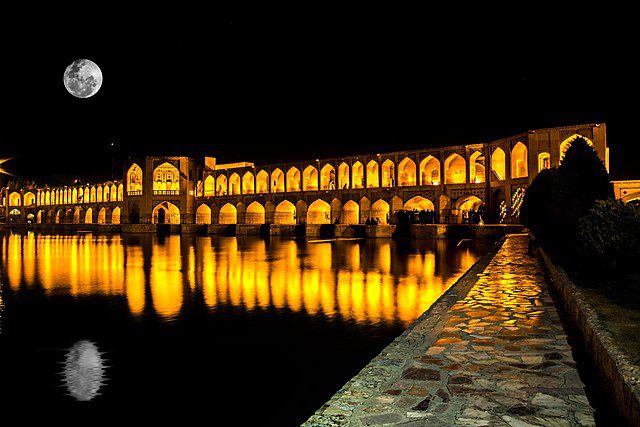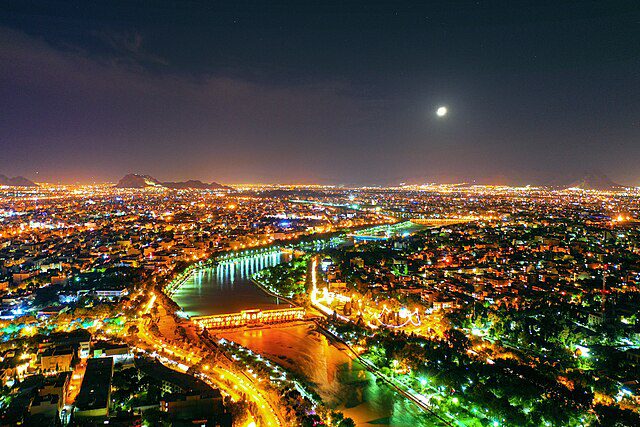Table of Contents
Stretching gracefully over the calm waters of Isfahan, the Khaju Bridge stands tall as a symbol of Persian brilliance. Built in 1650 by Shah Abbas II, the famous Safavid ruler, this bridge is more than just a way to cross the river. It’s a lively spot where people gather and history comes to life.
With its beautiful tiles and paintings, the bridge is a sight to behold. Every corner tells a story, making it more than just a bridge—it’s like walking through a painting. At its center sits a special pavilion where Shah Abbas once sat, taking in the view. Though his chair is gone, the stone seat remains, reminding us of his time there. Walking across the bridge, visitors are transported back in time, soaking in the rich history of Persia that’s woven into every inch of the bridge.
Khaju Bridge History
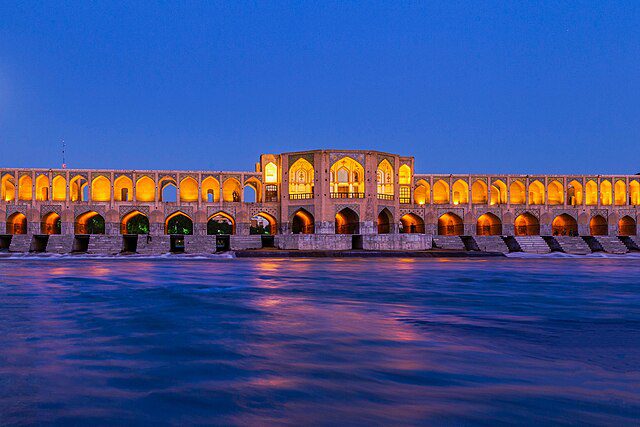
The Khaju Bridge, also known as Pol-e Khajoo (or Pole Khaju), is one of Iran’s most famous bridges. It was built around 1650, during the time of Abbas II, the seventh king of the Safavid dynasty. This remarkable structure was constructed on the foundations of an older bridge. Records show that in 1873, some repairs were made to the bridge.
Throughout its long history, the bridge has seen a few changes, but its beauty and strength remain intact. With its graceful arches and intricate design, the bridge continues to attract visitors, offering a glimpse into Iran’s rich cultural past. As people walk across its ancient stones, they step back in time, connecting with the stories of those who came before them. The bridge stands today as a proud symbol of Iran’s enduring heritage and craftsmanship.
Khaju Bridge Architect
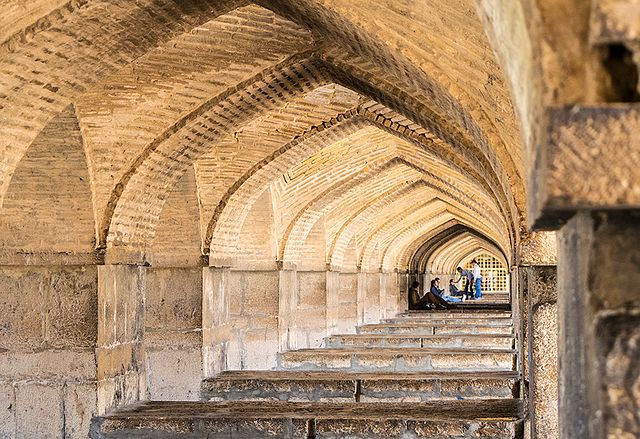
Step onto the Khaju Bridge and witness the stunning beauty of Persian architecture. This bridge is a true work of art, decorated with beautiful tiles and paintings that you won’t want to miss. Every part of the bridge is filled with colorful designs and patterns that show the rich history of Iran.
Walk across the bridge and travel back in time. The walls of the bridge are covered in artwork that tells stories from the past. Every detail, from the tiles to the paintings, shows the amazing skills of the people who built it. Standing on the bridge, you can feel the history and beauty of Iran all around you.
Khaju Bridge Facts
Situated gracefully over the calm waters of the Zayanderud River, Khaju Bridge boasts not just a stunning design but also some truly amazing scenery around it. The area surrounding the bridge is simply stunning, so make sure you carve out some time to take it all in. From the bridge, you can soak in the beauty of the landscape that stretches out before you.
Whether it’s the swaying trees or the gentle flow of the river below, everything comes together to create a peaceful atmosphere that’s hard to beat. So, don’t rush as you cross the bridge – instead, pause and enjoy the spectacular views that await you at every step.
Khaju Bridge Location
Located in Isfahan, Iran, Khaju Bridge is a well-known structure with a rich history. It’s not just a bridge but also a place where people come together for meetings and social gatherings. The bridge is quite big, measuring 133 meters long and 12 meters wide, supported by 23 arches. It’s made of solid stones and bricks, and it has lots of small and big openings along its length. The bridge was fixed up in 1873 to keep it in good shape.
People don’t just use the bridge to cross the river; they also enjoy spending time here. With its unique design and strong construction, the bridge has become a symbol of Isfahan’s past and present. Whether it’s for a leisurely walk or a community meeting, the bridge continues to be a beloved spot for locals and tourists alike.
How to Get to Khaju Bridge
To reach the stunning Khaju Bridge, your first stop is the ancient city of Isfahan. If you’re already in Isfahan, getting to the bridge is a breeze. Just hop in a car and enjoy the ride. Isfahan itself is a beautiful city, so you’ll have plenty of lovely sights to see along the way. Whether you rent a car or take public transportation, you’re in for a scenic journey.
As you travel through Isfahan’s charming streets, get ready to be wowed by the beauty that leads up to this magnificent bridge.
Recommended Sightseeing Time of Khaju Bridge
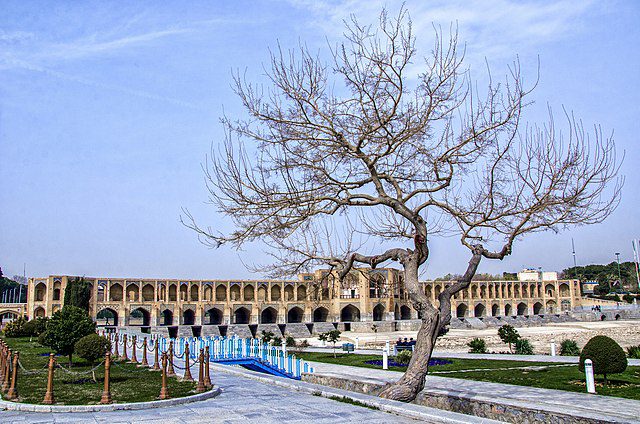
Visiting Pole Khaju is a must, no matter the time of day. In daylight, the bridge looks stunning, showing off its beautiful design and cool arches in the sunshine. Walking along it during the day lets you see all the fine details up close and feel the history all around you.
But the fun doesn’t stop when the sun goes down! At night, the bridge gets a makeover with twinkling lights that make it look super romantic. You’ll see couples taking leisurely walks, and the sounds of the water and people chatting add to the cozy atmosphere. Whether you’re there during the day or at night, this bridge promises a memorable experience that’ll stay with you long after you’ve left.
Where to Eat Near Khaju Bridge
Lotus Cafe & Restaurant
Lotus Cafe & Restaurant near Khaju Bridge is a cozy spot with yummy food. It’s a mix of modern and traditional styles, making it a comfy place to grab a bite. They serve up tasty dishes, from kebabs to salads, and the staff are friendly too. If you’re hungry near the bridge, check out Lotus Cafe & Restaurant.
Grill Studio
Grill Studio is perfect for meat lovers. They cook up all kinds of tasty grilled dishes like steak and burgers. They use really good ingredients and the atmosphere is cozy. Whether you’re with friends or on a date, Grill Studio is the place for delicious grilled food near the bridge.
Feel Cafe
Feel Cafe is another great option near the bridge. It’s a cozy spot where you can grab a cup of coffee and relax. The atmosphere is nice, and they have a good selection of drinks to choose from. Whether you’re meeting a friend or just need a break, Feel Cafe is the perfect place to unwind near the bridge.
Where to Stay Near Khaju Bridge
Parsian Suite Hotel
Situated just across Pole Khaju, the Parsian Suite Hotel offers a comfy stay by the Zayandeh River. You’ll find modern rooms and a taste of traditional hospitality here.
Pol and Park Hotel
Right by the bridge, Pol and Park Hotel gives you a peaceful retreat by the river. It’s a cozy spot with a touch of local charm, perfect for a relaxed stay.
Espadana Hotel
With its prime location near the bridge, Espadana Hotel combines elegance and convenience. Enjoy comfortable rooms and easy access to Isfahan’s attractions.
Other Attractions Near Khaju Bridge
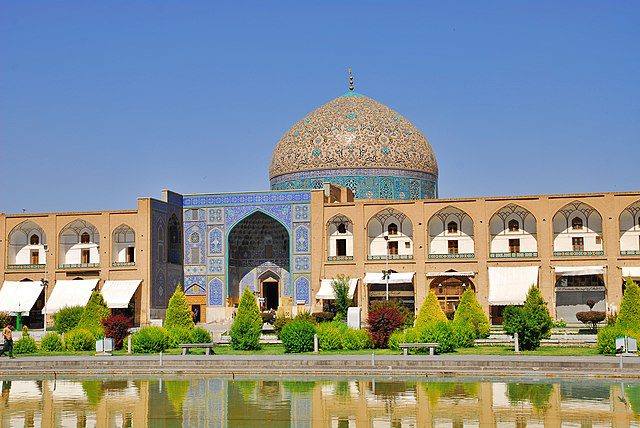
Sheikh Lotfollah Mosque
Nestled within Naqsh-e Jahan Square, Sheikh Lotfollah Mosque showcases the beauty of Safavid architecture. Though smaller, it’s packed with stunning designs. Step inside and be surrounded by lovely tiles and patterns that create a peaceful feeling. Don’t forget to look up at the domed ceilings where sunlight peeks through, adding to the mosque’s charm.
The Grand Bazaar
Explore the lively Grand Bazaar, a bustling hub of Iranian life. Get lost in its maze-like streets filled with vendors selling everything from crafts to spices. Bargaining is the norm here, so don’t hesitate to negotiate.
Whether you’re shopping for souvenirs or just enjoying the lively atmosphere, the Grand Bazaar offers a peek into Isfahan’s vibrant culture.
The Shah Mosque
Shah Mosque is a magnificent building dating back to the Safavid era. As you step inside, you’ll be amazed by its grandeur, with towering minarets and intricate tiles. The prayer hall is particularly breathtaking, adorned with colorful mosaics and intricate calligraphy. Take a stroll around the courtyard, soaking in the beauty of this architectural masterpiece.
FAQs about Khaju Bridge
Q1: Where is Khaju Bridge?
A1: Khaju Bridge is in Isfahan, Iran, over the Zayanderud River. It’s 133 meters long, 12 meters wide, and has 23 arches.
Q2: What’s the story behind Khaju Bridge?
A2: Khaju Bridge was built in 1650 by Shah Abbas II, the seventh king of the Safavid dynasty. It got some repairs in 1873.
Q3: Who made Khaju Bridge?
A3: The text doesn’t say who made Khaju Bridge.
Q4: How do I get to Khaju Bridge?
A4: First, go to Isfahan, then take a car or public transport to reach the bridge.
Q5: When’s the best time to visit Khaju Bridge?
A5: It’s good to visit Khaju Bridge both during the day and at night. During the day, you can see its design and history, and at night, it looks romantic with twinkling lights.
Last Words: Discover the Best of Khaju Bridge with a Customized Tour
The Khaju Bridge in Isfahan, Iran was built in 1650 by Shah Abbas II. It’s not just a bridge but a gathering place full of history. The bridge is decorated with beautiful tiles and paintings, telling stories everywhere you look. There’s a special pavilion in the middle where Shah Abbas used to sit. Even though his chair is gone, the stone seat is still there. Walking across the bridge feels like stepping into the past, surrounded by Persia’s rich history.
When planning a trip to Iran to soak in the beauty of Khaju Bridge and other cultural gems, it’s wise to consider a personalized journey that matches your interests. Choosing an Iran Tour with To Iran Tour means putting your travel dreams in the hands of experts who are dedicated to making your trip unforgettable. From where you stay to what you eat, and all the cultural adventures in between, To Iran Tour ensures every detail is taken care of.
Get ready to experience the best of Iran with us by your side.

